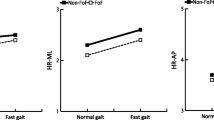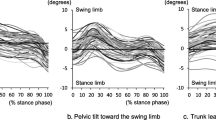Abstract
Background
Knee osteoarthritis (OA) and fear of falling (FoF) are important factors contributing to trunk oscillation during walking. It is of a clinical importance to clarify the association of FoF with trunk oscillation during walking in older adults with knee OA (knee OA adults).
Aim
The purpose of this study was to investigate the association of FoF with trunk oscillation during walking in knee OA adults.
Methods
Forty-one patients who met the criteria participated in the study and were classified into two groups based on their answer to a question on FoF. An accelerometer was attached at the level of the third lumbar vertebra (L3) and the seventh cervical vertebra (C7), and the accelerations at L3 and C7 were measured during a 10-m gait test. Using these data, the acceleration-derived gait indices, such as stride time variability (STV), root mean square (RMS), and autocorrelation at the trunk in the anteroposterior (AP) and mediolateral (ML) directions, were computed.
Results
FoF was associated with a higher STV value and a smaller RMS value in the ML direction at L3.
Discussion
The decreased trunk oscillation in the ML direction in knee OA adults with FoF may reflect a positive, compensatory adaptation for trunk control.
Conclusion
Knee OA adults with FoF decreased trunk oscillation during walking than those without FoF.

Similar content being viewed by others
References
Tinetti ME, Richman D, Powell L (1990) Falls efficacy as a measure of fear of falling. J Gerontol 45:239–243
Reelick MF, van Iersel MB, Kessels RP et al (2009) The influence of fear of falling on gait and balance in older people. Age Ageing 38:435–440
Chamberlin ME, Fulwider BD, Sanders SL et al (2005) Does fear of falling influence spatial and temporal gait parameters in elderly persons beyond changes associated with normal aging? J Gerontol A Biol Sci Med Sci 60:1163–1167
Donoghue OA, Cronin H, Savva GM et al (2013) Effects of fear of falling and activity restriction on normal and dual task walking in community dwelling older adults. Gait Posture 38:120–124
Sawa R, Doi T, Misu S et al (2014) The association between fear of falling and gait variability in both leg and trunk movements. Gait Posture 40:123–127
Asai T, Misu S, Sawa R et al (2017) The association between fear of falling and smoothness of lower trunk oscillation in gait varies according to gait speed in community-dwelling older adults. J Neuroeng Rehabil 14:5
Asai T, Misu S, Doi T et al (2014) Effects of dual-tasking on control of trunk movement during gait: respective effect of manual- and cognitive-task. Gait Posture 39:54–59
de Hoon EW, Allum JH, Carpenter MG et al (2003) Quantitative assessment of the stops walking while talking test in the elderly. Arch Phys Med Rehabil 84:838–842
Bautmans I, Jansen B, Van Keymolen B et al (2011) Reliability and clinical correlates of 3D-accelerometry based gait analysis outcomes according to age and fall-risk. Gait Posture 33:366–372
McGibbon CA, Krebs DE (2002) Compensatory gait mechanics in patients with unilateral knee arthritis. J Rheumatol 29:2410–2419
Messier SP, Devita P, Cowan RE et al (2005) Do older adults with knee osteoarthritis place greater loads on the knee during gait? A preliminary study. Arch Phys Med Rehabil 86:703–709
Mundermann A, Dyrby CO, Hurwitz DE et al (2004) Potential strategies to reduce medial compartment loading in patients with knee osteoarthritis of varying severity: reduced walking speed. Arthritis Rheum 50:1172–1178
Mundermann A, Asay JL, Mundermann L et al (2008) Implications of inceased medio-lateral trunk sway for ambulatory mechanics. J Biomech 41:165–170
Hunt MA, Brimingham TB, Bryant D et al (2008) Lateral trunk lean explains variation in dynamic knee joint load in patients with medial compartment knee osteoarthritis. Osteoarthr Cartil 16:591–599
Levinger P, Menz HB, Wee E et al (2011) Physiological risk factors for falls in people with knee osteoarthritis before and early after knee replacement surgery. Knee Surg Sports Traumatol Arthrosc 19:1082–1089
Tsonga T, Michalopoulou M, Kapetanakis S et al (2016) Risk factors for fear of falling in elderly patients with severe knee osteoarthritis before and one year after total knee arthroplasty. J Orthop Surg (Hong Kong) 24:302–306
Stanmore EK, Oldham J, Skelton DA et al (2013) Risk factors for falls in adults with rheumatoid arthritis: a prospective study. Arthritis Care Res (Hoboken) 65:1251–1258
Unver B, Ertekin Ö, Karatosun V (2014) Pain, fear of falling and stair climbing ability in patients with knee osteoarthritis before and after knee replacement: 6 month follow-up study. J Back Musculoskelet Rehabil 27:77–84
Maki BE, Holliday PJ, Topper AK (1991) Fear of falling and postural performance in the elderly. J Gerontol 46:123–131.15
Ayoubi F, Launay CP, Annweiler C et al (2015) Fear of falling and gait variability in older adults: a systematic review and meta-analysis. J Am Med Dir Assoc 16:14–19
Moe-Nissen R (1998) A new method for evaluating motor control in gait under real-life environmental conditions. Part 1: The instrument. Clinical Biomech 13:320–327
Kavanagh JJ, Menz HB (2008) Accelerometry: a technique for quantifying movement patterns during walking. Gait Posture 28:1–15
Zijlstra W (2004) Assessment of spatio-temporal parameters during unconstrained walking. Eur J Appl Physiol 92:39–44
Hausdorff JM, Cudkowicz ME, Firtion R et al (1998) Gait variability and basal ganglia disorders: stride-to-stride variations of gait cycle timing in Parkinson’s disease and Huntington’s disease. Mov Disord 13:428–437
Moe-Nilssen R, Helbostad JL (2004) Estimation of gait cycle characteristics by trunk accelerometry. J Biomech 37:121–126
Mizner RL, Petterson SC, Snyder-Mackler L (2005) Quadriceps strength and the time course of functional recovery after total knee arthroplasty. J Orthop Sports Phys Ther 35:424–436
Williamson A, Hoqqart B (2005) Pain: a review of three commonly used pain rating scales. J Clin Nurs 14:798–804
Van der Esch M, Steultjens MP, Harlaar J et al (2011) Lateral trunk motion and knee pain in osteoarthritis of the knee: a cross-sectional study. BMC Musculoskelet Disord 12:141
Hinman RS, Bennell KL, Metcalf BR et al (2002) Balance impairments in individuals with symptomatic knee osteoarthritis: a comparison with matched controls using clinical tests. Rheumatology 41:1388–1394
Kim HS, Yun DH, Yoo SD et al (2011) Balance control and knee osteoarthritis severity. Ann Rehabil Med 35:701–709
Legters K (2002) Fear of falling. Phys Ther 82:264–272
Stanmore EK, Oldham J, Skelton DA et al (2013) Fall incidence and outcomes of falls in a prospective study of adults with rheumatoid arthritis. Arthritis Care Res (Hoboken) 65:737–744
Tsonga T, Michalopoulou M, Malliou P et al (2015) Analyzing the history of falls in patients with severe knee osteoarthritis. Clin Orthop Surg 7:449–456
Lord SR, Menz HB, Tiedemann A (2003) A physiological profile approach to falls risk assessment and prevention. Phys Ther 83:237–252
Sturnieks DL, Tiedemann A, Chapman K et al (2004) Physiological risk factors for falls in older people with lower limb arthritis. J Rheumatol 31:2272–2279
Zijlstra G, van Haastregt JC, van Eijk JT et al (2005) Evaluating an intervention to reduce fear of falling and associated activity restriction in elderly persons: design of a randomised controlled trial [ISRCTN43792817]. BMC Public Health 5:26
Acknowledgements
We acknowledge all subjects who participated in this study, and this study did not receive any specific grant from funding agencies in the public, commercial, or not-for-profit sectors.
Author information
Authors and Affiliations
Corresponding author
Ethics declarations
Conflict of interest
The authors declare that they have no conflict of interest.
Ethical approval
All procedures performed in studies involving human participants were in accordance with the ethical standards of the institutional and/or national research committee and with the 1964 Helsinki declaration and its later amendments or comparable ethical standards.
Informed consent
All participants provided a written informed consent in accordance with the Declaration of Helsinki before participating.
Rights and permissions
About this article
Cite this article
Oka, T., Asai, T., Kubo, H. et al. Association of fear of falling with acceleration-derived gait indices in older adults with knee osteoarthritis. Aging Clin Exp Res 31, 645–651 (2019). https://doi.org/10.1007/s40520-018-1022-x
Received:
Accepted:
Published:
Issue Date:
DOI: https://doi.org/10.1007/s40520-018-1022-x




